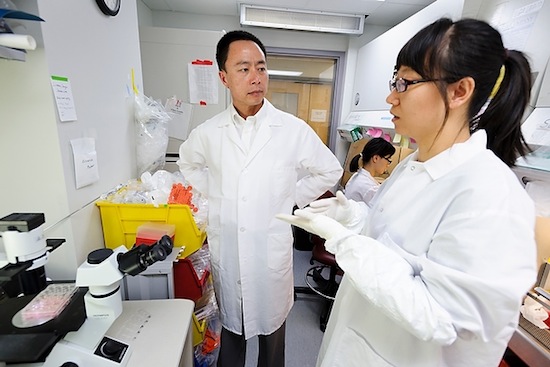Adult cells transformed into early-stage nerve cells, bypassing the pluripotent stem cell stage

Su-Chun Zhang (center), professor of neuroscience in the School of Medicine and Public Health, talks with postdoctoral student Lin Yao in his research lab at the Waismam Center.
Photo: Jeff Miller
A UW–Madison research group has converted skin cells from people and monkeys into a cell that can form a wide variety of nervous-system cells — without passing through the do-it-all stage called the induced pluripotent stem cell, or iPSC.
Bypassing the ultraflexible iPSC stage was a key advantage, says senior author Su-Chun Zhang, a professor of neuroscience and neurology. “IPSC cells can generate any cell type, which could be a problem for cell-based therapy to repair damage due to disease or injury in the nervous system.”
In particular, the absence of iPSC cells rules out the formation of tumors by pluripotent cells in the recipient, a major concern involving stem cell therapy.
A second advance comes from the virus that delivers genes to reprogram the adult skin cells into a different and more flexible form. Unlike other viruses used for this process, the Sendai virus does not become part of the cell’s genes.
Progenitor cells grown from the skin of ALS or spinal muscular atrophy patients can be transformed into various neural cells to model each disease and allow rapid drug screening. … Eventually, the process could produce cells used to treat conditions like spinal cord injury and ALS.
Jianfeng Lu, Zhang’s postdoctoral research associate at the UW–Madison Waisman Center, removed skin cells from monkeys and people, and exposed them to Sendai virus for 24 hours. Lu then warmed the culture dish to kill the virus without harming the transforming cells. Thirteen days later, Lu was able to harvest a stem cell called an induced neural progenitor. After the progenitor was implanted into newborn mice, neural cells seemed to grow normally, without forming obvious defects or tumors, Zhang says.
Other researchers have bypassed the pluripotent stem cell stage while turning skin cells into neurons and other specialized cells, Zhang acknowledges, but the new research, just published in Cell Reports, had a different goal. “Our idea was to turn skin cells to neural progenitors, cells that can produce cells relating to the neural tissue. These progenitors can be propagated in large numbers.”
The research overcomes limitations of previous efforts, Zhang says. First, the Sendai virus, a kind of cold virus, is considered safe because it does not enter the cell’s DNA, and it is killed by heat within 24 hours. (This is quite similar to the fever that raises our temperature to remove cold virus.) Second, the neural progenitors have a greater ability to grow daughter cells for research or therapy. Third, the progenitor cells are already well along the path toward specialization, and cannot become, say, liver or muscle cells after implantation. Finally, the progenitors can produce many more specialized cells.
The neurons that grew from the progenitor had the markings of neurons found in the rear of the brain, and that specialization can also be helpful. “For therapeutic use, it is essential to use specific types of neural progenitors,” says Zhang. “We need region-specific and function-specific neuronal types for specific neurological diseases.”
Progenitor cells grown from the skin of ALS (Lou Gehrig’s disease) or spinal muscular atrophy patients can be transformed into various neural cells to model each disease and allow rapid drug screening, Zhang adds.
Eventually, the process could produce cells used to treat conditions like spinal cord injury and ALS.
“These transplantation experiments confirmed that the reprogrammed cells indeed belong to cells of the intended brain regions and the progenitors produced the three major classes of neural cells: neurons, astrocytes and oligodendrocytes,” Zhang says. “This proof-of-principle study highlights the possibility to generate many specialized neural progenitors for specific neurological disorders.”
Tags: animal research, research, stem cells, Waisman Center




